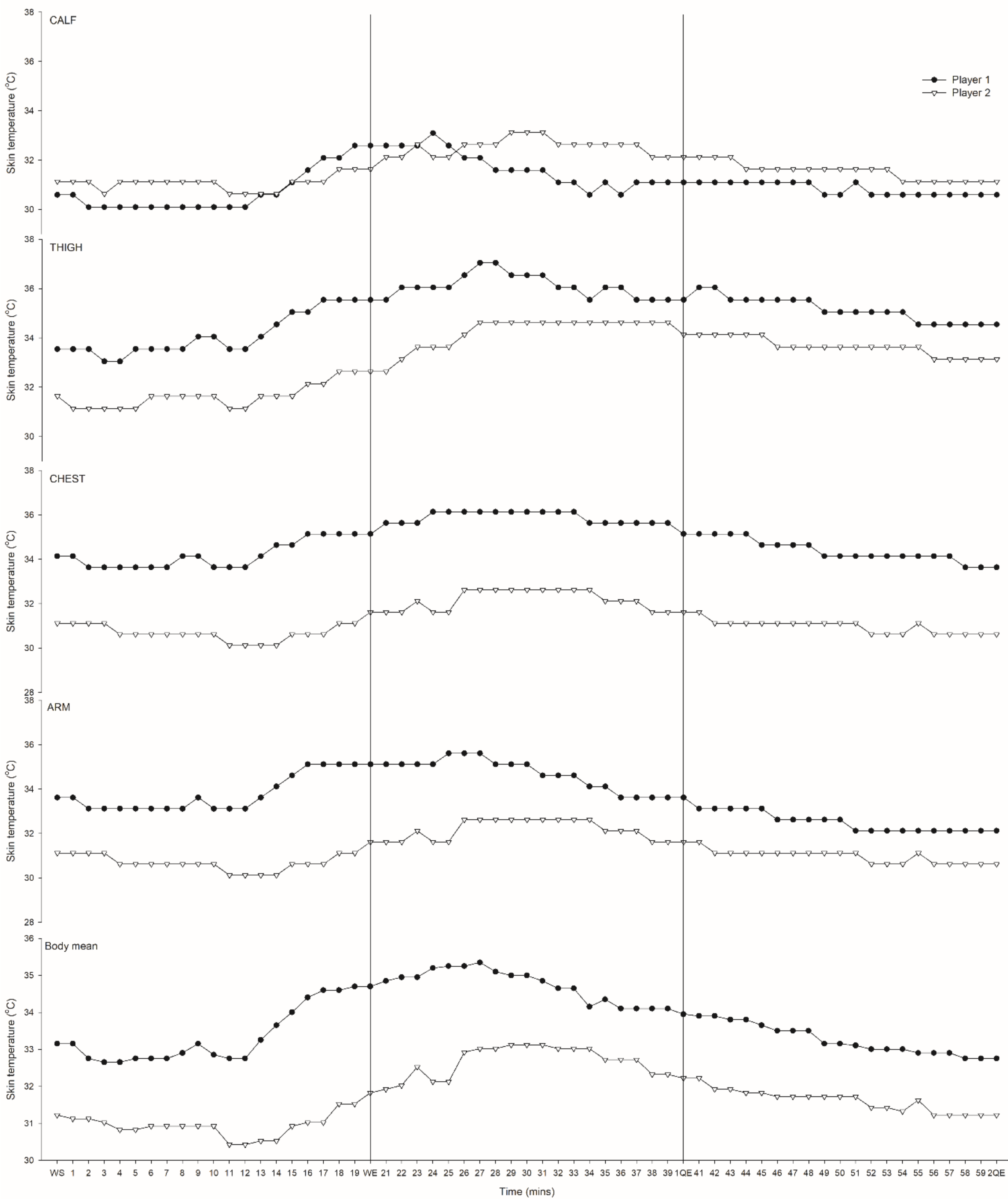Influence of Rest on Players’ Performance and Physiological Responses during Basketball Play
Abstract
:1. Introduction
2. Methods
2.1. Subjects
2.2. Procedures
Warm-Up
2.3. Measures
2.3.1. Anthropometric Assessment
2.3.2. Counter Movement Jump
2.3.3. Core Temperature
2.3.4. Skin Temperature
2.3.5. Heart Rate
3. Results
3.1. CMJ Performance
3.2. Core Temperature
3.3. Skin Temperature
3.4. Heart Rate
4. Discussion
5. Practical Applications
- A standardized warm up considerably increases physiological and performance responses for basketball players that may contribute to enhanced match performance.
- Inactivity for a substantial period (6 min) following warm up demonstrates the players’ HR level returning to baseline and the start of skin temperature decrease obtained during the warm-up. Without running an off-court warm-up, substituting a player from this point on into the game may pose a risk for substitute strategies. However, the results of this study should be interpreted with caution given the small sample size.
- Implementation of a devised warm up to enhance core/skin temperature for substitute players immediately before they engage with competition may optimize player performances for a positive match outcome.
Author Contributions
Conflicts of Interest
References
- Bishop, D. Warm up I: Potential mechanisms and the effects of passive warm up on exercise performance. Sports Med. 2003, 33, 439–454. [Google Scholar] [CrossRef] [PubMed]
- Anderson, P.; Landers, G.; Wallman, K. Effect of warm-up on intermittent sprint performance. Res. Sports Med. 2014, 22, 88–99. [Google Scholar] [CrossRef] [PubMed]
- Carling, C.; Espie, V.; Le Gall, F.; Bloomfield, J.; Jullien, H. Work-rate of substitutes in elite soccer: A preliminary study. J. Sci. Med. Sport 2010, 13, 253–255. [Google Scholar] [CrossRef] [PubMed]
- Murray, A.M.; Varley, M.C. Activity Profile of International Rugby Sevens: Effect of Score Line, Opponent, and Substitutes. Int. J. Sports Physiol. Perform. 2015, 10, 791–801. [Google Scholar] [CrossRef] [PubMed]
- Gomez, M.A.; Silva, R.; Lorenzo, A.; Kreivyte, R.; Sampaio, J. Exploring the effects of substituting basketball players in high-level teams. J. Sports Sci. 2016, 35, 247–254. [Google Scholar] [CrossRef] [PubMed]
- Pliauga, V.; Kamandulis, S.; Dargeviciute, G.; Jaszczanin, J.; Kliziene, I.; Stanislovaitiene, J.; Stanislovaitis, A. The Effect of a Simulated Basketball Game on Players’ Sprint and Jump Performance, Temperature and Muscle Damage. J. Hum. Kinet. 2015, 46, 167–175. [Google Scholar] [CrossRef] [PubMed]
- Galazoulas, C.; Tzimou, A.; Karamousalidis, G.; Mougios, V. Gradual decline in performance and changes in biochemical parameters of basketball players while resting after warm-up. Eur. J. Appl. Physiol. 2012, 112, 3327–3334. [Google Scholar] [CrossRef] [PubMed]
- Moreira, A.; McGuigan, M.R.; Arruda, A.F.; Freitas, C.G.; Aoki, M.S. Monitoring internal load parameters during simulated and official basketball matches. J. Strength Cond. Res. 2012, 26, 861–866. [Google Scholar] [CrossRef] [PubMed]
- Ramanathan, N.L. A New Weighting System for Mean Surface Temperature of the Human Body. J. Appl. Physiol. 1964, 19, 531–533. [Google Scholar] [PubMed]
- Meckel, Y.; Gottieb, R.; Eliakim, A. Repeated sprint tests in young basketball players at different game stages. Eur. J. Appl. Physiol. 2009, 107, 273–279. [Google Scholar] [CrossRef] [PubMed]



© 2017 by the authors. Licensee MDPI, Basel, Switzerland. This article is an open access article distributed under the terms and conditions of the Creative Commons Attribution (CC BY) license (http://creativecommons.org/licenses/by/4.0/).
Share and Cite
Crowther, R.G.; Leicht, A.S.; Pohlmann, J.M.; Shakespear-Druery, J. Influence of Rest on Players’ Performance and Physiological Responses during Basketball Play. Sports 2017, 5, 27. https://doi.org/10.3390/sports5020027
Crowther RG, Leicht AS, Pohlmann JM, Shakespear-Druery J. Influence of Rest on Players’ Performance and Physiological Responses during Basketball Play. Sports. 2017; 5(2):27. https://doi.org/10.3390/sports5020027
Chicago/Turabian StyleCrowther, Robert G., Anthony S. Leicht, Jessica M. Pohlmann, and Jane Shakespear-Druery. 2017. "Influence of Rest on Players’ Performance and Physiological Responses during Basketball Play" Sports 5, no. 2: 27. https://doi.org/10.3390/sports5020027





